
展览
EXHIBITION
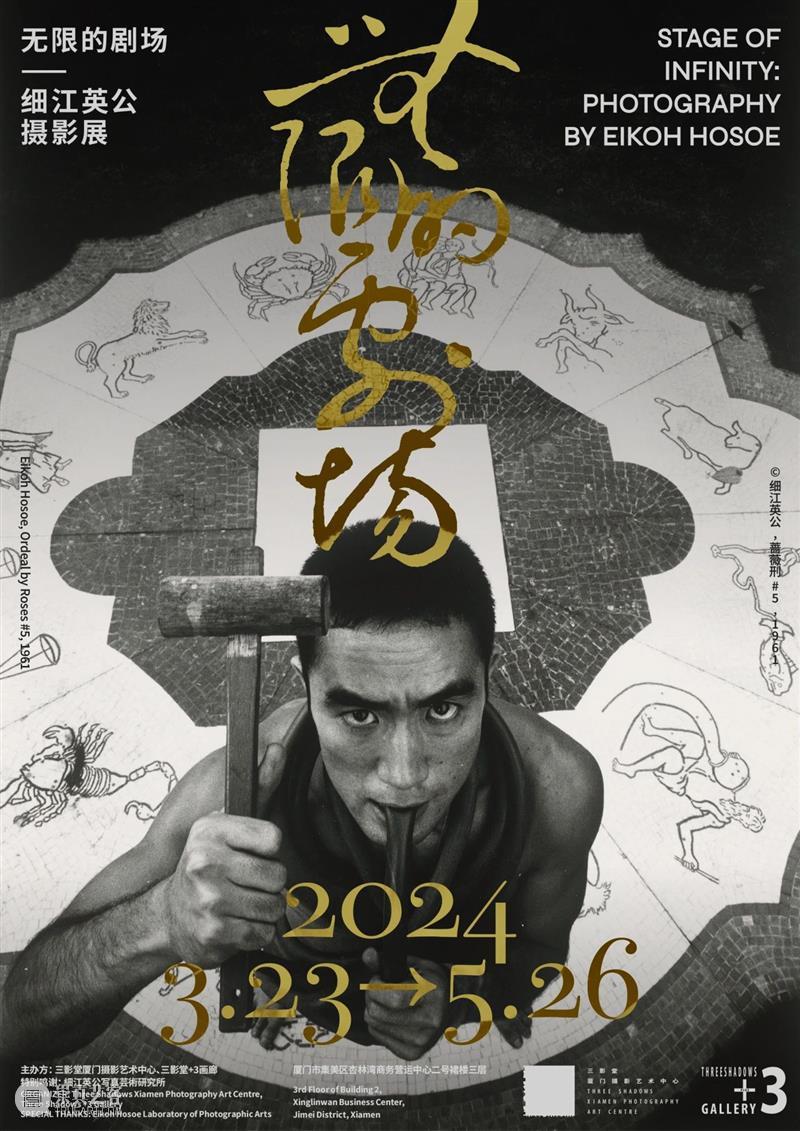
无限的剧场
—— 细江英公摄影展
展期:2024.3.23-5.26 (周一闭馆)
开幕:2024.3.23 15:00
地址:厦门市集美区杏林湾营运中心2号楼裙楼三层
主办:三影堂厦门摄影艺术中心、三影堂+3画廊
鸣谢:细江英公写真艺术研究所
艺术总监:荣荣&映里
展览联动合作伙伴:HARPERs FLORAL
● Please scroll down for English
三影堂厦门摄影艺术中心联合三影堂+3画廊,共同呈现“无限的剧场——细江英公摄影展”。本次展览为日本著名摄影艺术家细江英公在中国的首次大型回顾展,也是继北京首展后的第一场巡展。展览集中呈现艺术家创作生涯中7组代表系列、39幅经典作品,通过历史性的梳理和叙述,回望上世纪50至70年代活跃的日本艺坛,并重现细江英公通过镜头所创造的黑白经典。
细江英公是最具国际声望的日本摄影代表人物之一。1933年出生于日本山形县,自1950年代起致力于摄影创作活动。在战后日本摄影仍以纪实和报道为主的情况下,细江英公开始了对表现内心意识的探索。1957年,他的作品参展摄影评论家福岛辰夫策划的“10人之眼”,1959年,同其他前卫摄影师联合创立VIVO团体,与当时为主流的“写实主义摄影运动”相抗衡,从而推出强调主观性和个人化的摄影风格。
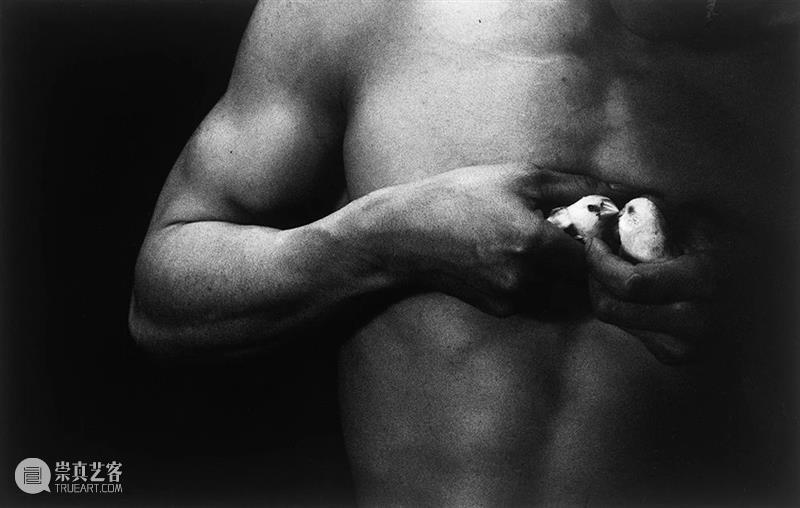
细江英公,《男与女 #33》,1960
Eikoh Hosoe, Man and Woman #33, 1960
细江英公成名的1955至1965年,正是战后日本最重要的十年。经济高速发展的同时,出现了影响日本至今的一批前卫文化人士,包括暗黑舞踏宗师土方巽、文学剧作家三岛由纪夫、先锋艺术家草间弥生等。细江英公年轻时与他们交往甚密,种种实验和开放的合作契机,造就了一系列极富戏剧张力和浓烈叙事性的摄影作品。在拍摄过程中,才华横溢的表达者产生共鸣,灵感和思维在镜头前的特定时空交织碰撞、相互作用,最终凝结形成一股强大的表达能量,在细江按下快门的刹那被捕捉。
与其仅仅拍摄某一主体,细江英公将自己视为在这个特定时空中的共同创作者之一。他的掌镜在现实既定时空中制造出一道裂痕,使得土方巽或三岛由纪夫可以步入其中自由地演绎。
—— 中森康文,纽约亚洲协会美术馆馆长
细江英公长期以来使用身体表现独立影像美学,追求并探索情感与精神的本质表达。1960年首先发表的《男与女》便是他明确这一志向后的开创性影像实验。《男与女》从艺术角度切入社会现实,是一部极具前卫风格的人体研究作品。画面高反差的色调、出乎意料的构图,以及作为摄影主体的男女互动演绎和探索性姿态,将两性之间经典永恒的差异、关系和秩序刻画得淋漓尽致。
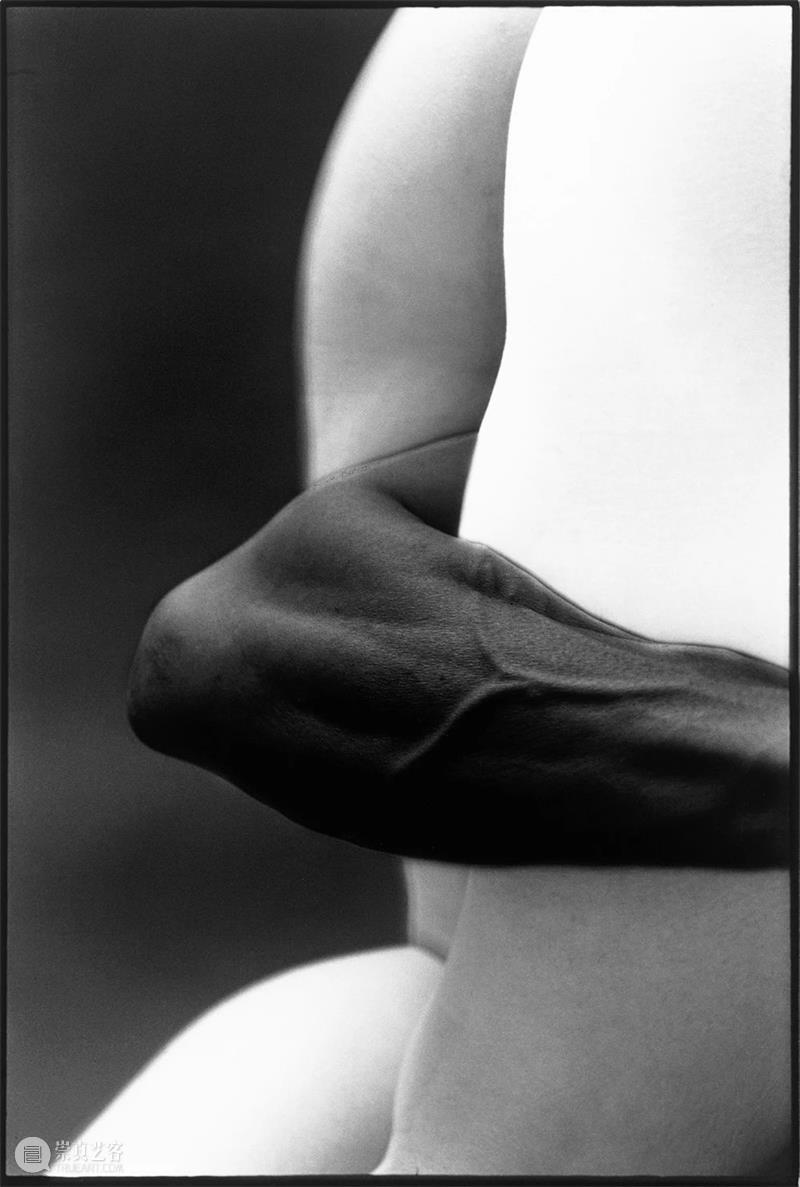
细江英公,《抱拥 #52》,1971
Eikoh Hosoe, Embrace #52, 1971
1971年出版《抱拥》被普遍认为是《男与女》的续篇,是细江英公对自己人体作品的重新审视。十年间,细江始终思考着人类力量、美感、存在性的合理表达。最终,在安静而紧张环境中完成拍摄的《抱拥》将赤裸的人体局部抽象提纯,富有线条感的“形”将生命的优雅与灵魂的高贵发挥到极致。
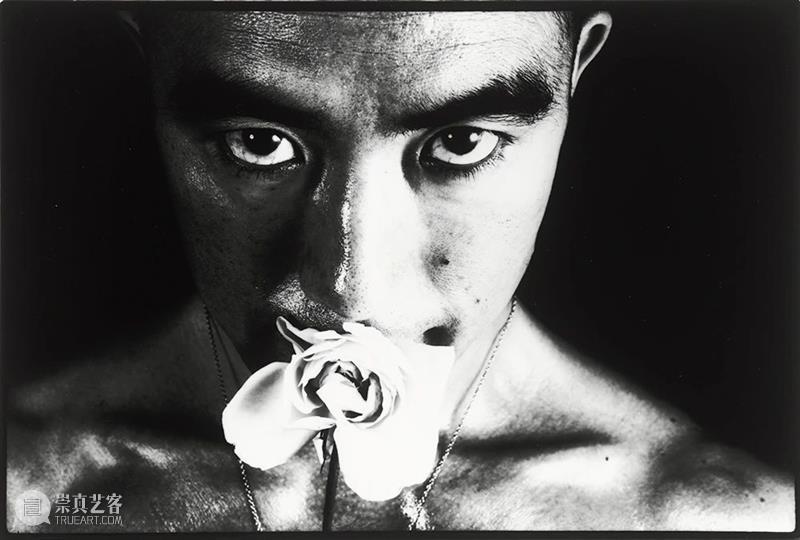
细江英公,《蔷薇刑 #32》,1961
Eikoh Hosoe, Ordeal by Roses #32, 1961
细江英公与三岛由纪夫结缘于一项拍摄任务,而后的1961年秋至1962年夏期间,两人合作完成的《蔷薇刑》无疑成为迄今为止传播最广且最富盛名的系列。在《蔷薇刑》中,细江构建了一个华丽而强烈的叙事。在维多利亚时期的庭院、洛可可风格的房间、文艺复兴绘画的阴影中,三岛由纪夫被隐藏在繁复的艺术装潢之中,他坚定的凝视仿佛构成了与死亡的极端对立,而健美的肢体展现出对生的渴望热切。
有一天,细江英公先生来了,他将我的肉体带入奇妙的世界。我被他的镜头推向了一个异常、扭曲、讽刺、怪诞、狂野、泛性的世界。仿佛在看似无尽的暗渠中,情感的底流抒发着潺潺之音。
—— 三岛由纪夫
1959至1960年是暗黑舞踏成为现代文化运动的起点,也是细江英公作为先锋摄影师的起步之年。细江与土方巽在几年后合作的《镰鼬》将这一全新舞蹈形式搬到了日本东北部的村庄,这是一场关于“禁忌”与“解放”的探索实验。土方巽一系列偶发的肢体演绎,或愤怒、或狂喜、或寂静,如同日本民间传说中的镰鼬一般狡诈怪奇。细江追随着土方巽在田野和村庄中奔跑跳跃,精妙地穿梭在村民和孩童的身影之间。这些生动的黑白影像揭开了细江童年记忆的面纱,关于苦难、恐惧、战栗、绝望的阴影在被唤起的同时也得到了沉淀和治愈。
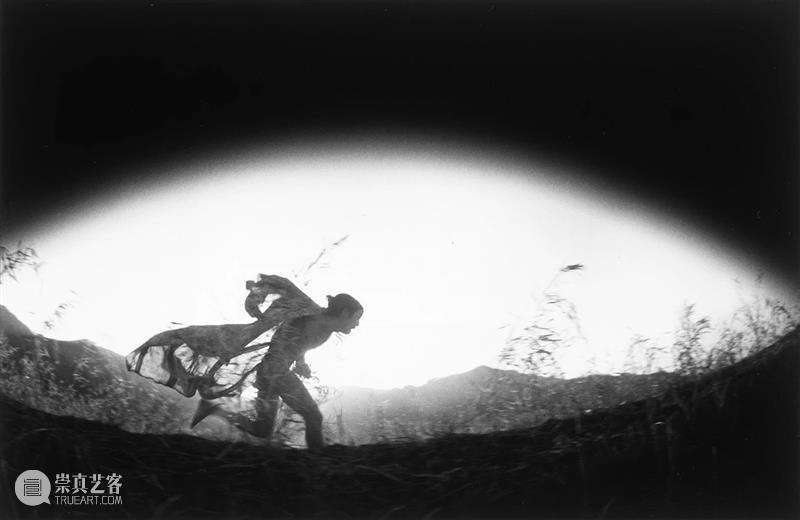
细江英公,《镰鼬 #31》,1968
Eikoh Hosoe, Kamaitachi #31, 1968
纵观所有拍摄主体,与细江英公摄影气质最为相通的是另一位舞踏家大野一雄。细江热爱他的舞蹈——大野一雄的战时经历使他亲眼目睹过地狱般的惨景,因此对于人类深藏在内心的痛苦、脆弱、悲伤刻骨铭心。这些灵魂深处的复杂情感,通过缓慢而安静的舞姿散发出巨大的能量。细江对大野一雄的拍摄长达46年之久,这些作品在这位伟大的舞踏家百岁之际编纂收录进《蝴蝶之梦》。
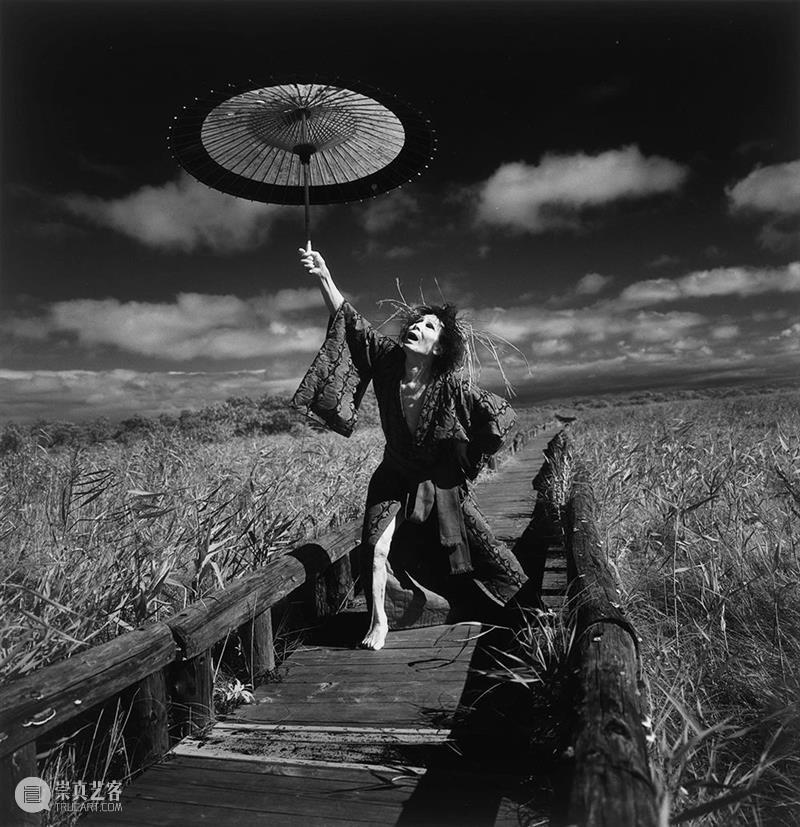
细江英公, 《大野一雄,在钏路湿原起舞 IV》,1994
Eikoh Hosoe, Kazuo Ohno, Dancing in Kushiro Marsh IV, 1994
1964年,细江英公首次离开国土并前往欧美旅行。他在纽约与众多友人会面,并为当时在国际上初露头角的草间弥生进行了一组拍摄。《纽约14番街》以草间弥生的工作室地址命名,记录了这位年轻的前卫艺术家在职业初期的行为艺术和创作幕后。细江通过多次曝光的方式构造草间弥生的重叠幻影,似乎暗示着身在异乡两人之间的惺惺相惜。
细江英公的作品是完全个人化的,而他的创作灵感往往基于与某一人物的独特相遇——先锋剧团成员四谷西蒙便基于此成为了《西蒙·私风景》的拍摄主体。这位身着奇装异服、妆容打扮精致、富有双性气质的戏剧演员,唤醒了细江少年记忆中的东京风景。在浅草寺、鸠之街、吾妻桥等地,西蒙充满活力的身姿形态和面部表情与现实社会的城市景观形成鲜明对比。细江的影像记录将西蒙内心的“私密”与城市外部的“风景”相连,诸如此的叙事手法赋予了这部作品独特的表现力和美学。
我只拍自己熟悉的、感兴趣的人。拍摄的时候,我要把他带到我熟悉的环境里面,按照我的方式来拍,那就是我的“细江剧场”:在那里,我是制作人、导演、观众,也是评论家,被拍摄的人在为我做一场隆重的演出。
—— 细江英公
细江英公的创作往往给人以暗黑、压抑、扭曲、激进之感,这些讲述着肉体、性别、生死和情感的超现实画面,显然与人们所熟悉的现实景观格格不入。然而,现实社会中所谓的秩序、规范、体面与公德,其表象下却暗藏着种种丑陋、肮脏和不可言说的一面。与之截然相反,细江英公的镜头恰恰不畏于揭露和直击裸露、荒诞、残酷的阴暗面——无论是《男与女》中被夹在手臂下的那张惊悚面孔,《蔷薇刑》中三岛由纪夫在蔷薇花后颇具攻击性的定睛凝视,还是《镰鼬》中土方巽在众目睽睽之下的张牙舞爪,《蝴蝶之梦》中大野一雄用枯萎的躯干对灵魂进行诠释——在“细江剧场”这一特定时空,闪耀着属于人性纯粹和本真的光辉,流淌着心灵深处清澈而真挚的情感。
●文/薛睿萌
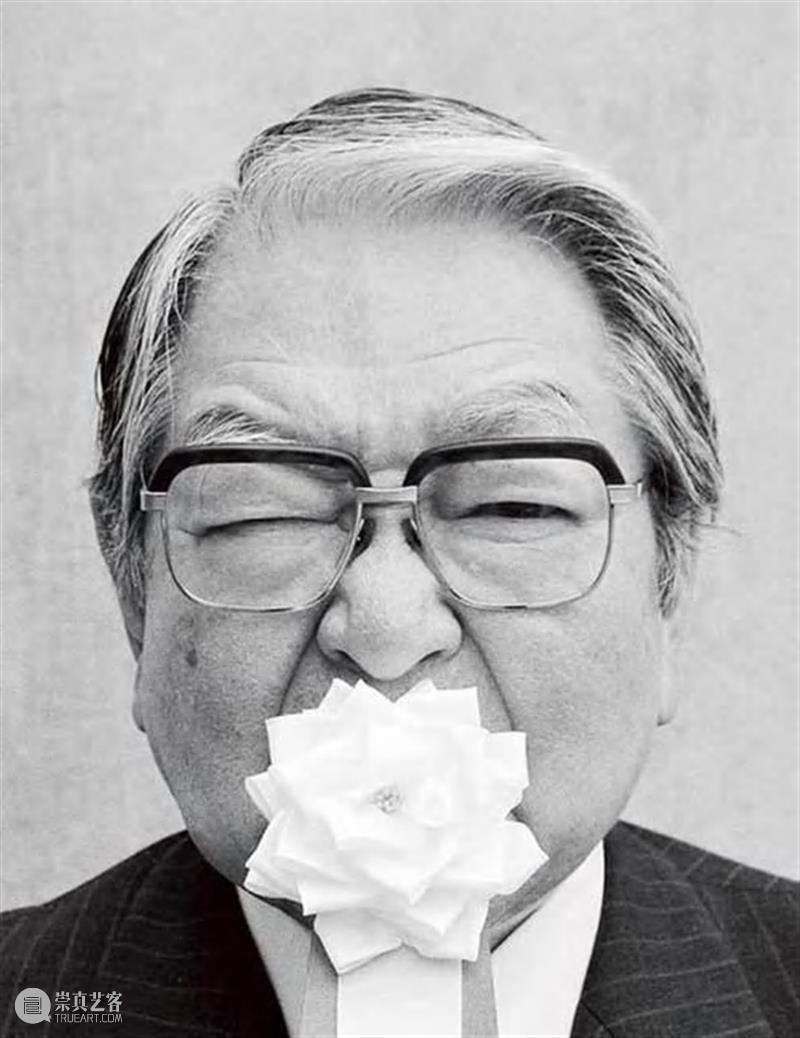
艺术家
细江 英公
1933年生于日本山形县。1951年在富士软片 (Fujifilm) 主办的“富士摄影大赛”中荣获学生组冠军。1954年大学毕业于东京写真短期大学,于1956年举办第一次个展“东京的美国女孩”。1957年参与摄影评论家福岛辰夫策划的展览“10人之眼”,因而偕同川田喜久治、佐藤明、丹野章、东松照明、奈良原一高等人共同成立摄影师团体“VIVO”,与当时主流的“写实主义摄影运动”抗衡,推出更为“个人”、更为“主观”的摄影风格。
细江自摄影生涯初始期的50年代起,便在人物描写上留下重大成果,1960年的个展“男与女”,荣获日本写真批评家协会新人赏。1963年拍摄三岛由纪夫的作品《蔷薇刑》,在艺坛得到广大回响,荣获日本写真批评家协会作家赏。1970年拍摄以秋田农村为舞台的舞蹈家土方巽,作品《镰鼬》荣获艺术选奖文部大臣赏。1998年获颁紫绶褒章,2003年得到英国皇家摄影协会创立150周年特别奖的表扬,2007年获颁旭日小授章,2008年荣获毎日艺术赏,2010年获日本政府选为文化功劳者,2017年获颁旭日重光章,得到日本海内外高度评价。
三影堂+3 画廊
三影堂+3画廊是三影堂摄影艺术中心旗下运营的艺术空间,创立于2012年4月。+3画廊致力于连接中国摄影的过去、现在和未来,连接中国本土与世界的通道,并以摄影为媒介促进海内外艺术文化交流发展。
+3画廊以推介中国最具代表性和成长性的摄影艺术家及其作品为首要目标,同时有计划地展示国外重要摄影艺术家的优秀作品。通过与海内外领先艺术机构和博览会合作,促进摄影艺术的传播与发展,增强中国摄影在世界范围内的呈现。+3画廊以国际化的商业运营模式和专业化的贴心服务,持续作为摄影艺术家和收藏家互通的优质平台。
Tel. +86 10 64322663
Email. info@plus3gallery.com
Web. www.plus3gallery.com
Insta. @plus3gallery
展览联动合作伙伴
HARPERs FLORAL
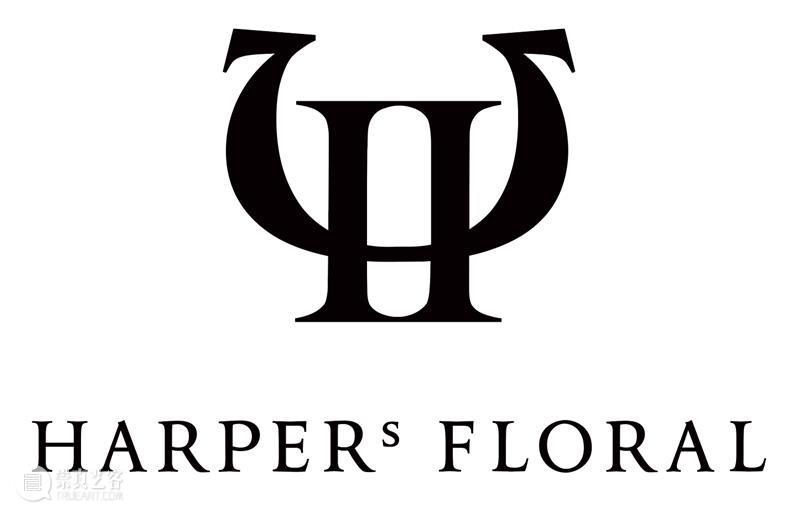
HARPERs FLORAL哈柏,是⼀个以“花”为创作素材与表达线索的花艺品牌。我们希望所有与花相关的创作都具有连接着所有时代的美感——在⾃然时效的框架下,以易逝的素材,创造趋向永恒的作品。目前Harpers在厦门、上海两座城市拥有线下美学体验空间,提供花礼零售服务。此外Harpers与众多国际品牌、餐饮品牌、艺术展廊合作,在互动对白中找寻共鸣,引导并传达新世代生活方式。
三影堂厦门 x HARPERs FLORAL联名花束将在“无限的剧场——细江英公摄影展”开幕之际同步推出。在摄影与花艺这两种创作形式里,我们试图探寻驻留美好、消解时间的共同答案。
观众有机会在Harpers线下门店以优惠价购买三影堂厦门门票,同时Harpers门店还将设有主题蔷薇装置,敬请期待!更多信息请关注后续推文。
STAGE OF INFINITY:
PHOTOGRAPHY BY EIKOH HOSOE
Duration: March 23rd, 2024 - May 26th, 2024 (Close on Monday)
Opening: March 23rd, 2024 15:00
Venue:3rd Floor of Building 2, Xinglinwan Business Centre, Jimei District, Xiamen
Organisers: Three Shadows Xiamen Photography Art Centre, Three Shadows +3 Gallery
Special Thanks: Eikoh Hosoe Laboratory of Photographic Arts
Art Director: RongRong&inri
Crossover Partner: HARPERs FLORAL
Three Shadows Xiamen Photography Art Centre, in collaboration with Three Shadows +3 Gallery, is proud to unveil "STAGE OF INFINITY: PHOTOGRAPHY BY EIKOH HOSOE". This exhibition heralds the first significant retrospective in China of Eikoh Hosoe, a prominent Japanese photographic artist. Following its debut in Beijing, this tour showcases seven of Hosoe’s iconic photography series which are 39 of his classic works. This historical retrospective revisits the vibrant art scene in Japan from the 1950s to the 1970s, bringing to light the timeless black-and-white masterpieces crafted through Hosoe’s lens.
Renowned as one of the most internationally esteemed Japanese photographers, Eikoh Hosoe was born in 1933 in Yamagata-ken, Japan. Beginning his photography career in the 1950s, Hosoe embarked on a quest to explore the realms of inner consciousness amidst a Japanese post-war photography scene predominantly focused on social realism and reportage. His work gained notable attention in 1957 when showcased in "The Eyes of Ten", an exhibition curated by photography critic Tatsuo Fukushima. In 1959, Hosoe, alongside other avant-garde photographers, co-founded the VIVO group, challenging the era’s mainstream "Photorealism Movement". This collective effort marked the advent of a photography style rich in subjectivity and personal form of creative expression, setting a new direction away from the prevailing norms.
During the transformative period of 1955 to 1965, post-war Japan experienced its most crucial decade, coinciding with rapid economic growth and the rise of avant-garde cultural figures. Among them were Butoh dancer Tatsumi Hijikata, novelist and playwright Yukio Mishima and experimental artist Yayoi Kusama. Eikoh Hosoe, in his youth, formed close relationships with these luminaries. Their experimental and open collaborations yielded a series of dramatically intense and narrative-rich photographs. In the shooting process, the exceptionally talented artists resonated with each other, with their inspiration and thoughts intertwining and colliding, ultimately coalescing into a powerful expressive force that was captured in the instant Hosoe pressed the shutter.
Instead of simply photographing the subject, he began to view himself as involved in the creation of a distinct space and time. Armed with his camera, Hosoe created a rupture in the conventional time and space of reality, which Hijikata and Mishima could enter and perform within.
——Yasufumi Nakamori, Director of the Asia Society Museum, New York
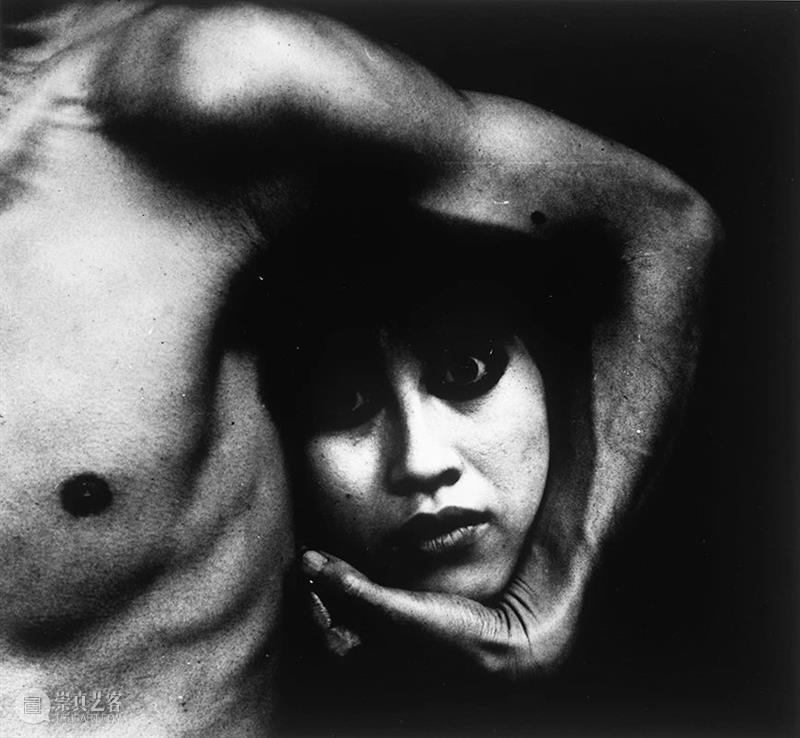
细江英公,《男与女 #20》,1960
Eikoh Hosoe, Man and Woman #20, 1960
Eikoh Hosoe has long committed to the pursuit of an independent aesthetic through human bodies, exploring the profound expressions of emotion and spirit. His groundbreaking work Man and Woman in 1960 serves as a pioneering experiment that solidified such artistic direction. This avant-garde study of the human form delves into societal realities through art, featuring high-contrast color tones, unexpected composition of the pictures and the dynamic interaction and exploratory postures of male and female subjects, which masterfully describe the eternal nuances, relationships and hierarchies between man and woman.
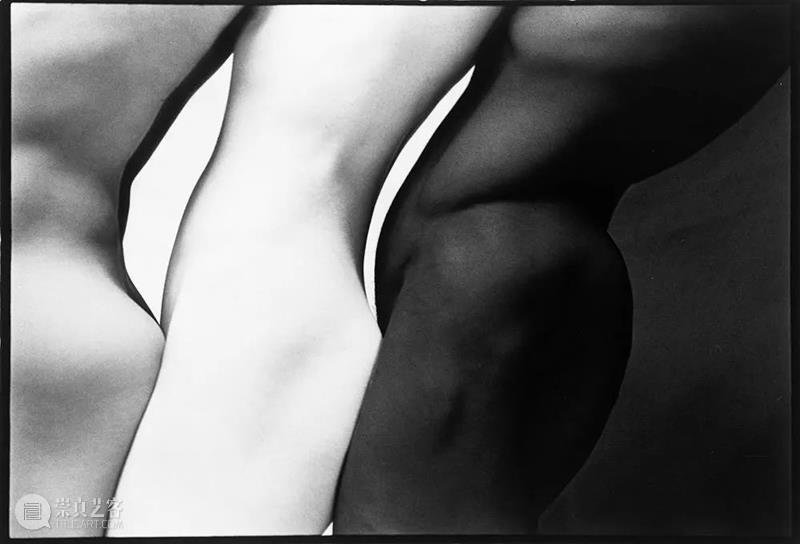
细江英公, 《抱拥 #60》, 1970
Eikoh Hosoe, Embrace #60, 1970
Published in 1971, Embrace is often seen as a sequel to Man and Woman, marking Eikoh Hosoe’s reflective journey into the essence of his work with human bodies. For a decade, Hosoe delved into the articulate expression of human strength, aesthetics and being. Ultimately, captured at a serene yet intense night, Embrace abstracted naked human bodies into exquisite "forms", celebrating the elegance of life and the nobility of the soul to its fullest extent.
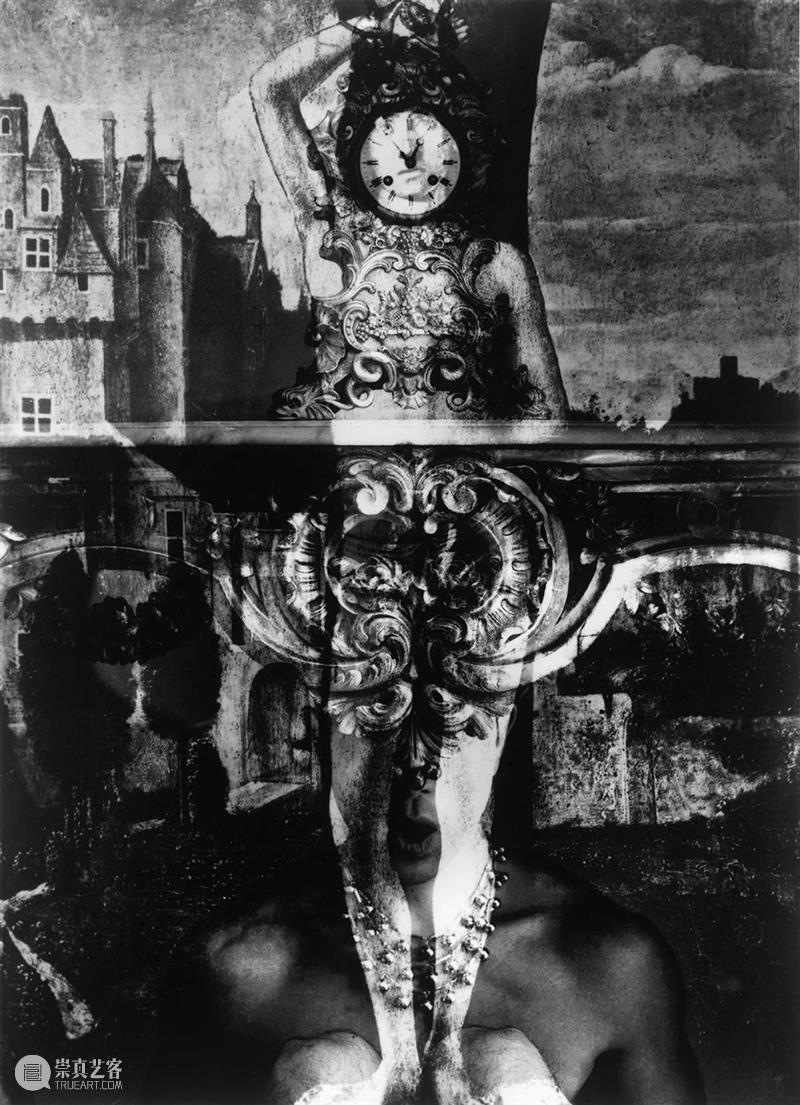
细江英公,《蔷薇刑 #29》,1962
Eikoh Hosoe, Ordeal by Roses #29, 1962
Eikoh Hosoe’s connection with Yukio Mishima sparked during a photographic project and later blossomed into the creation of Ordeal by Roses between Autumn 1961 and Summer 1962. This series, which has become one of the most widely disseminated and celebrated of his works, showcases a resplendent and intense narrative. Set against the backdrop of a Victorian courtyard, Rococo-style rooms and the shadows of Renaissance paintings, Mishima concealed with these elaborate artistic decors. His intense gaze and the muscular definition of his body convey a stark opposition to death and a fervent longing for life.
One day, Eikoh Hosoe stopped by and whisked me away to a mysterious world. The world into which I was ushered by the wizardry of his lens was alien, contorted, derisive, grotesque, barbaric, and dissipated, and yet it was also a realm in which the murmurs of a pure undercurrent of lyricism flowed through some unseen conduit.
—Yukio Mishima
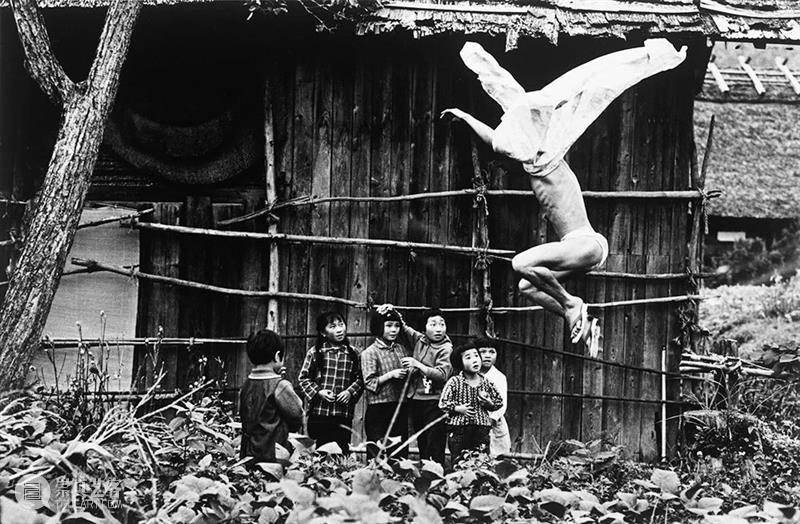
细江英公,《镰鼬 #17》,1965
Eikoh Hosoe, Kamaitachi #17, 1965
Between 1959 and 1960, the genesis of Butoh as the modern cultural movement and the emergence of Eikoh Hosoe as an avant-garde photographer signified a pivotal period. Kamaitachi, jointly created by Hosoe and Tatsumi Hijikata years after, moved the stage of Butoh dance to villages in northeastern Japan, embarking on an exploratory journey of "taboos" and "liberation". A series of impromptu performances made by Tatsumi Hijikata, ranging from anger, ecstasy to silence, mirrored the cunning and peculiar nature of Kamaitachi from Japanese folklore. Following the figure of Tatsumi Hijikata, Hosoe was running and jumping in the fields and villages, capturing moments among villagers and children with great agility. These monochromes vividly unveiled the childhood memories of Hosoe, rising a mixed emotion of suffering, fear, shiver and desperation, which, through the lens of his camera, found healing and resolution over time.
Among all the subjects he photographed, Eikoh Hosoe shared the deepest connection with Butoh dancer Kazuo Ohno. Hosoe deeply admired Ohno’s dance, which was profoundly influenced by his wartime experiences of witnessing horrific scenes of living hell, leaving indelible marks of human suffering, vulnerability and sorrow. These complex emotions of the soul were powerfully expressed through Ohno’s measured and tranquil movements. Hosoe’s collaboration with Ohno spanned 46 years, culminating in the inclusion of these remarkable photographs in The Butterfly Dream when commemorating the legendary dancer’s centenary.
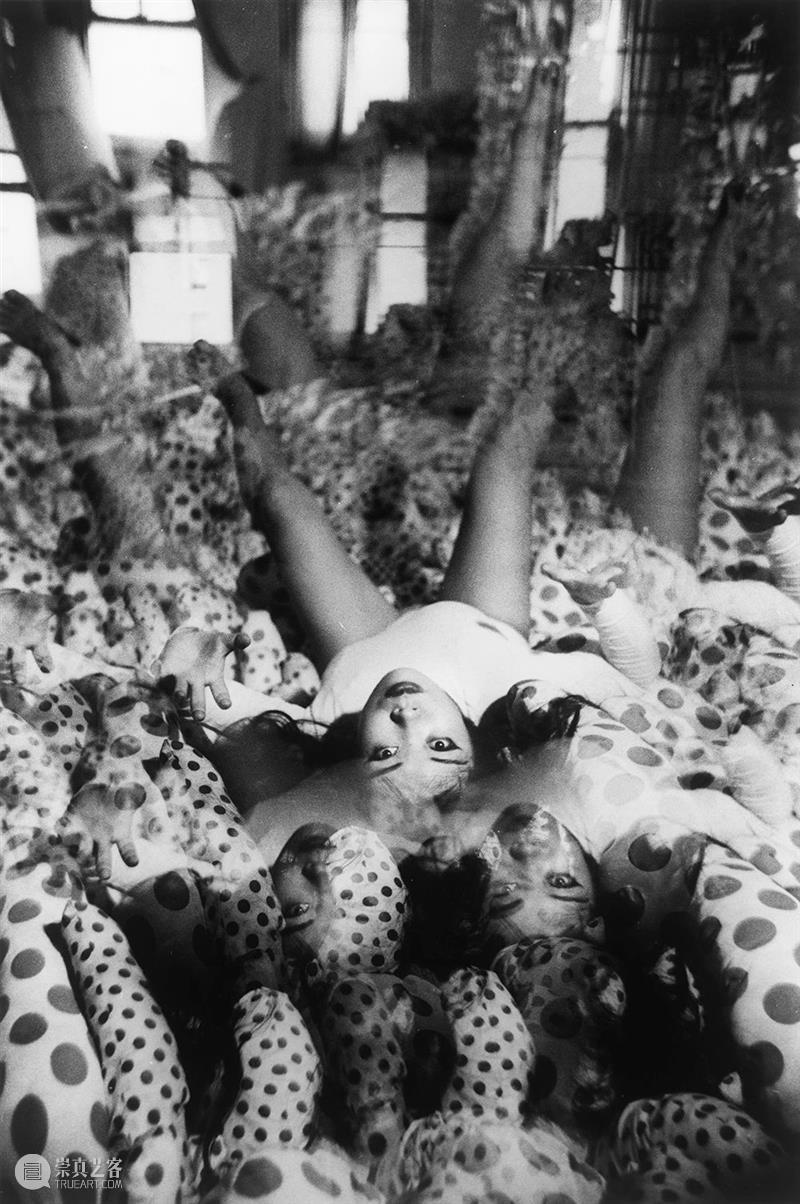
细江英公,《纽约14番街·草间工作室》,1964
Eikoh Hosoe, New York 14 Street, Kusama Studio, 1964
In 1964, Eikoh Hosoe embarked on his first journey outside Japan to Europe and America. In New York, he reunited with friends and conducted a photo session with the emerging international artist Yayoi Kusama. Named after the studio of Yayoi Kusama, New York 14th Street records the early performance art and creation behind the scenes of this young avant-garde artist. Hosoe used multiple exposures to create overlapping images of Yayoi Kusama, subtly reflecting the mutual empathy between two compatriots on a foreign land.
Eikoh Hosoe’s works are intensely personal, drawing inspiration from unique encounters, notably with the avant-garde theater member Simon Yotsuya, who is immortalized in Simon, A Private Landscape. Yotsuya, with his distinctive attire, meticulous makeup and effeminate allure, revives the Tokyo of Hosoe’s youth. His dynamic poses and expressions starkly contrast with urban backdrops like Asakusa Kannon Temple, Hatonomachi Street and Azumabashi Bridge. Hosoe weaves Simon’s intimate world with the external urban landscape, bestowing the series with unparalleled expressiveness and aesthetic depth.
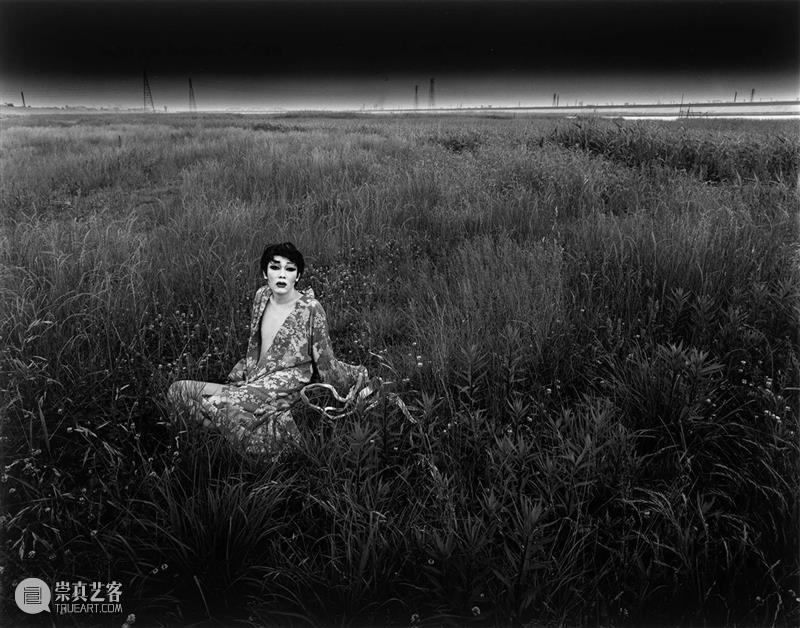
细江英公,《西蒙·私风景:荒川放水路附近》,1968
Eikoh Hosoe, Simon, A Private Landscape, 1968
I only photograph people I know well and find genuinely intriguing. During the sessions, I immerse them in an environment I am familiar with and capture them in my way. This is my "Hosoe Theater", where I am the producer, director, audience, and even the critic, watching the subjects stage a magnificent performance exclusively for me.
— Eikoh Hosoe
Eikoh Hosoe’s series are characterized by darkness, oppression, distortion and radicalism, confronting the surreal aspects of the body, gender, life, death and emotion which starkly diverge from conventional reality. Contrasting with the societal facade of order and morality, which conceals ugliness and indecency, Hosoe fearlessly exposes the raw, absurd and brutal facets of existence. His works in "Hosoe Theater", from the terror in a face trapped beneath an arm in Man and Woman, to Yukio Mishima’s intense stare behind roses in Ordeal by Roses, Tatsumi Hijikata’s dramatic gestures in Kamaitachi and Kazuo Ohno’s soulful interpretation with his emaciated body in The Butterfly Dream, all reveal a glittering purity and authenticity of human spirit amidst the darkness, underscoring a profound exploration of genuine and deep-seated emotions.

ARTIST
Eikoh Hosoe
Born 1933 in Yamagata Prefecture, and graduated from Tokyo Junior College of Photography (currently Tokyo Polytechnic University) in 1954. Eikoh Hosoe participated in the exhibition "The Eyes of Ten" in 1957, organised by photography critic Tatsuo Fukushima. This exhibition led Hosoe to meet photographers Kikuji Kawada, Akira Sato, Akira Tanno, Shomei Tomatsu and Ikko Narahara, and together they formed the independent photo agency VIVO. This agency positioned itself against the then-popular Realism Photography Movement, and instead developed more "personal" and "subjective" modes of photographic expression.
At the beginning of Hosoe’s career in the 1950s, he produced many important portraits of people, and he won the Japan Photo Critics Association Newcomer’s Award for his 1960 solo exhibition "Man and Woman" . His 1963 work Ordeal by Roses, featuring the author Yukio Mishima as a model, elicited a huge response, and Hosoe was eventually recognised with the Japan Photo Critics Association Artist Award. His 1970 work Kamaitachi, which was produced in a farming village in the Akita Prefecture with the butoh dancer Tatsumi Hijikata, won The Ministry of Education, Science and Culture’s Arts Encouragement Prize. Hosoe has an esteemed reputation worldwide with numerous awards received in Japan and abroad.
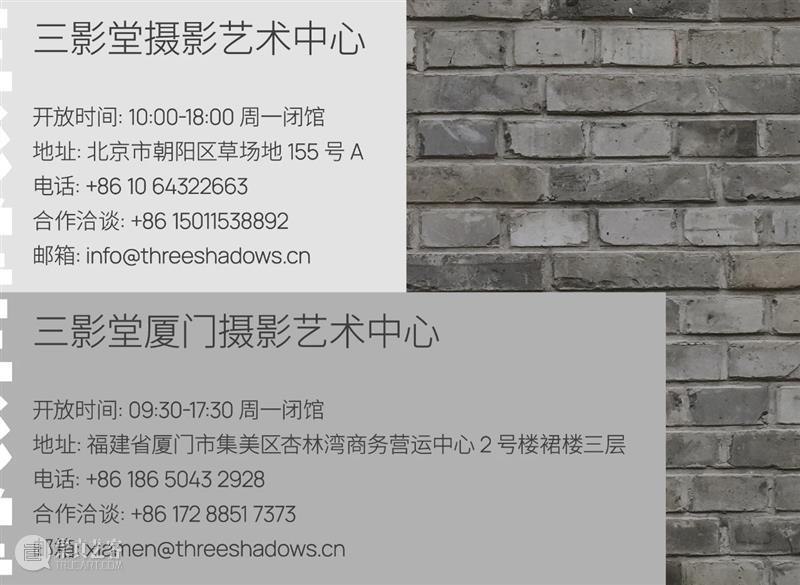



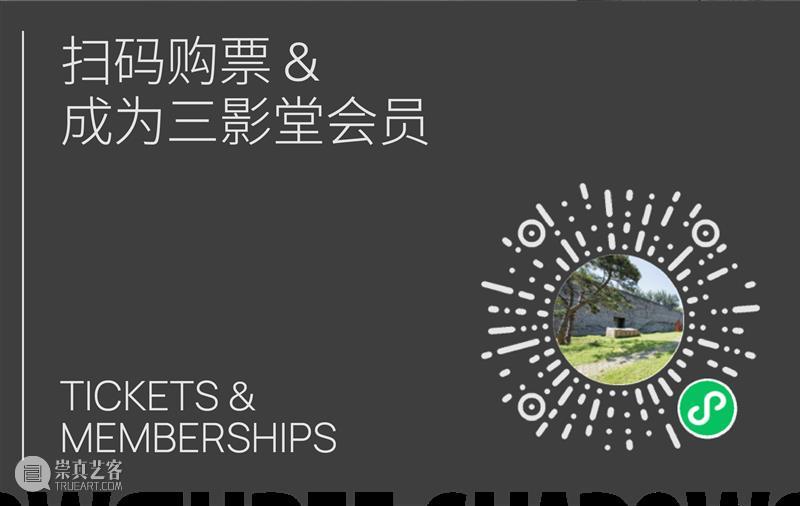
三影堂厦门正在展出


合作展览



已展示全部
更多功能等你开启...





 分享
分享